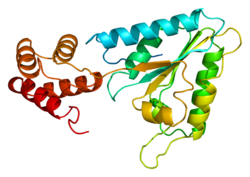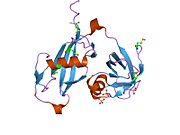| NSF |
|---|
 |
| Identifiers |
|---|
| Aliases |
NSF, SKD2, N-ethylmaleimide sensitive factor, N-ethylmaleimide sensitive factor, vesicle fusing ATPase, SEC18, DEE96 |
| External IDs |
OMIM: 601633 MGI: 104560 HomoloGene: 4502 GeneCards: NSF |
|
| Gene location (Mouse) |
|---|
 |
| Chr. |
Chromosome 11 (mouse) |
|
| Band |
11 E1|11 67.54 cM |
Start |
103,712,608 bp |
| End |
103,844,882 bp |
|
|
RNA expression pattern |
|---|
| Bgee |
| Human |
Mouse (ortholog) |
| Top expressed in |
- superior frontal gyrus
- prefrontal cortex
- Brodmann area 9
- cerebellar cortex
- cerebellar hemisphere
- nucleus accumbens
- hypothalamus
- islet of Langerhans
- hippocampus proper
- caudate nucleus
|
|
| Top expressed in |
- pontine nuclei
- subiculum
- medial dorsal nucleus
- medial vestibular nucleus
- dorsal tegmental nucleus
- superior colliculus
- medial geniculate nucleus
- ventral tegmental area
- dorsomedial hypothalamic nucleus
- piriform cortex
|
|
| More reference expression data |
|
| BioGPS |
|
|
|
|
| Wikidata |
|
N-ethylmaleimide-sensitive factor, also known as NSF or N-ethylmaleimide sensitive fusion proteins, is an enzyme which in humans is encoded by the NSF gene.
Function
NSF is a homohexameric AAA ATPase involved in membrane fusion. NSF is ubiquitously found in the membrane of eukaryotic cells. It is a central component of the cellular machinery in the transfer of membrane vesicles from one membrane compartment to another. During this process, SNARE proteins on two joining membranes (usually a vesicle and a target membrane such as the plasma membrane) form a complex, with the α-helical domains of the SNAREs coiling around each other and forming a very stable four-helix bundle. As SNAREs intertwine, they pull the vesicle towards the target membrane, excluding water and promoting fusion of the vesicle with the target membrane. NSF unravels SNARE complexes once membrane fusion has occurred, using the hydrolysis of ATP as an energy source, allowing the dissociated SNAREs to be recycled for reuse in further rounds of membrane fusion. This proposal remains controversial, however. Recent work indicates that the ATPase function of NSF does not function in recycling of vesicles but rather functions in the act of fusing vesicles with the plasma membrane.
SNARE hypothesis
Because neuronal function depends on the release of neurotransmitters at a synapse — a process in which synaptic vesicles fuse with the presynaptic membrane — NSF is a key synaptic component. Thus, conditional temperature-sensitive mutations in the Drosophila melanogaster gene for NSF lead to a comatose behaviour at the restrictive temperature (and hence the gene is called comatose), presumably because neuronal functions are blocked. In Dictyostelium discoideum amoebae, similar mutations lead to a cessation of cell movement at the restrictive temperature, indicating a role for intracellular membrane transport in migration. Another neuronal role for NSF is indicated by its direct binding to the GluR2 subunit of AMPA type glutamate receptors (which detect the neurotransmitter glutamate). This gives NSF a putative role in delivery and expression of AMPA receptors at the synapse.
NSF was discovered by James Rothman and colleagues in 1987 while at Stanford University; they identified NSF after observing that a cytoplasmic factor, required for membrane fusions, was inactivated by treatment with N-ethylmaleimide. This assay enabled them to purify NSF.
Interactions
N-ethylmaleimide sensitive fusion protein has been shown to interact with NAPA.
Further reading
-
Wilson DW, Whiteheart SW, Wiedmann M, Brunner M, Rothman JE (May 1992). "A multisubunit particle implicated in membrane fusion". The Journal of Cell Biology. 117 (3): 531–8. doi:10.1083/jcb.117.3.531. PMC 2289450. PMID 1315316.
-
Hanson PI, Otto H, Barton N, Jahn R (Jul 1995). "The N-ethylmaleimide-sensitive fusion protein and alpha-SNAP induce a conformational change in syntaxin". The Journal of Biological Chemistry. 270 (28): 16955–61. doi:10.1074/jbc.270.28.16955. PMID 7622514.
-
Püschel AW, O'Connor V, Betz H (Jun 1994). "The N-ethylmaleimide-sensitive fusion protein (NSF) is preferentially expressed in the nervous system". FEBS Letters. 347 (1): 55–8. doi:10.1016/0014-5793(94)00505-2. PMID 8013662. S2CID 8148431.
-
Whiteheart SW, Rossnagel K, Buhrow SA, Brunner M, Jaenicke R, Rothman JE (Aug 1994). "N-ethylmaleimide-sensitive fusion protein: a trimeric ATPase whose hydrolysis of ATP is required for membrane fusion". The Journal of Cell Biology. 126 (4): 945–54. doi:10.1083/jcb.126.4.945. PMC 2120109. PMID 8051214.
-
Nagahama M, Orci L, Ravazzola M, Amherdt M, Lacomis L, Tempst P, Rothman JE, Söllner TH (May 1996). "A v-SNARE implicated in intra-Golgi transport". The Journal of Cell Biology. 133 (3): 507–16. doi:10.1083/jcb.133.3.507. PMC 2120813. PMID 8636227.
-
Hoyle J, Phelan JP, Bermingham N, Fisher EM (Nov 1996). "Localization of human and mouse N-ethylmaleimide-sensitive factor (NSF) gene: a two-domain member of the AAA family that is involved in membrane fusion". Mammalian Genome. 7 (11): 850–2. doi:10.1007/s003359900249. PMID 8875895. S2CID 21435412.
-
Jacobsson G, Meister B (Dec 1996). "Molecular components of the exocytotic machinery in the rat pituitary gland". Endocrinology. 137 (12): 5344–56. doi:10.1210/endo.137.12.8940356. PMID 8940356.
-
Timmers KI, Clark AE, Omatsu-Kanbe M, Whiteheart SW, Bennett MK, Holman GD, Cushman SW (Dec 1996). "Identification of SNAP receptors in rat adipose cell membrane fractions and in SNARE complexes co-immunoprecipitated with epitope-tagged N-ethylmaleimide-sensitive fusion protein". The Biochemical Journal. 320 (2): 429–36. doi:10.1042/bj3200429. PMC 1217948. PMID 8973549.
-
Germain-Lee EL, Obie C, Valle D (Aug 1997). "NVL: a new member of the AAA family of ATPases localized to the nucleus". Genomics. 44 (1): 22–34. doi:10.1006/geno.1997.4856. PMID 9286697.
-
Subramaniam VN, Loh E, Hong W (Oct 1997). "N-Ethylmaleimide-sensitive factor (NSF) and alpha-soluble NSF attachment proteins (SNAP) mediate dissociation of GS28-syntaxin 5 Golgi SNAP receptors (SNARE) complex". The Journal of Biological Chemistry. 272 (41): 25441–4. doi:10.1074/jbc.272.41.25441. PMID 9325254.
-
Lowe SL, Peter F, Subramaniam VN, Wong SH, Hong W (Oct 1997). "A SNARE involved in protein transport through the Golgi apparatus". Nature. 389 (6653): 881–4. Bibcode:1997Natur.389..881L. doi:10.1038/39923. PMID 9349823. S2CID 4421051.
-
Barnard RJ, Morgan A, Burgoyne RD (Nov 1997). "Stimulation of NSF ATPase activity by alpha-SNAP is required for SNARE complex disassembly and exocytosis". The Journal of Cell Biology. 139 (4): 875–83. doi:10.1083/jcb.139.4.875. PMC 2139964. PMID 9362506.
-
Osten P, Srivastava S, Inman GJ, Vilim FS, Khatri L, Lee LM, States BA, Einheber S, Milner TA, Hanson PI, Ziff EB (Jul 1998). "The AMPA receptor GluR2 C terminus can mediate a reversible, ATP-dependent interaction with NSF and alpha- and beta-SNAPs". Neuron. 21 (1): 99–110. doi:10.1016/S0896-6273(00)80518-8. PMID 9697855.
-
McDonald PH, Cote NL, Lin FT, Premont RT, Pitcher JA, Lefkowitz RJ (Apr 1999). "Identification of NSF as a beta-arrestin1-binding protein. Implications for beta2-adrenergic receptor regulation". The Journal of Biological Chemistry. 274 (16): 10677–80. doi:10.1074/jbc.274.16.10677. PMID 10196135.
-
Subramaniam VN, Loh E, Horstmann H, Habermann A, Xu Y, Coe J, Griffiths G, Hong W (Mar 2000). "Preferential association of syntaxin 8 with the early endosome" (PDF). Journal of Cell Science. 113 (6): 997–1008. doi:10.1242/jcs.113.6.997. PMID 10683148.
-
Sagiv Y, Legesse-Miller A, Porat A, Elazar Z (Apr 2000). "GATE-16, a membrane transport modulator, interacts with NSF and the Golgi v-SNARE GOS-28". The EMBO Journal. 19 (7): 1494–504. doi:10.1093/emboj/19.7.1494. PMC 310219. PMID 10747018.
-
Allan BB, Moyer BD, Balch WE (Jul 2000). "Rab1 recruitment of p115 into a cis-SNARE complex: programming budding COPII vesicles for fusion". Science. 289 (5478): 444–8. Bibcode:2000Sci...289..444A. doi:10.1126/science.289.5478.444. PMID 10903204.
-
Michaut M, Tomes CN, De Blas G, Yunes R, Mayorga LS (Aug 2000). "Calcium-triggered acrosomal exocytosis in human spermatozoa requires the coordinated activation of Rab3A and N-ethylmaleimide-sensitive factor". Proceedings of the National Academy of Sciences of the United States of America. 97 (18): 9996–10001. Bibcode:2000PNAS...97.9996M. doi:10.1073/pnas.180206197. PMC 27650. PMID 10954749.
-
Imai C, Sugai T, Iritani S, Niizato K, Nakamura R, Makifuchi T, Kakita A, Takahashi H, Nawa H (Jun 2001). "A quantitative study on the expression of synapsin II and N-ethylmaleimide-sensitive fusion protein in schizophrenic patients". Neuroscience Letters. 305 (3): 185–8. doi:10.1016/S0304-3940(01)01844-4. PMID 11403936. S2CID 20542930.
-
Kittler JT, Rostaing P, Schiavo G, Fritschy JM, Olsen R, Triller A, Moss SJ (Jul 2001). "The subcellular distribution of GABARAP and its ability to interact with NSF suggest a role for this protein in the intracellular transport of GABA(A) receptors". Molecular and Cellular Neurosciences. 18 (1): 13–25. doi:10.1006/mcne.2001.1005. PMID 11461150. S2CID 43244403.
|
PDB gallery
|
|---|
1d2n: D2 DOMAIN OF N-ETHYLMALEIMIDE-SENSITIVE FUSION PROTEIN
1nsf: D2 HEXAMERIZATION DOMAIN OF N-ETHYLMALEIMIDE SENSITIVE FACTOR (NSF)
1qcs: N-TERMINAL DOMAIN OF N-ETHYLMALEIMIDE SENSITIVE FACTOR (NSF)
1qdn: AMINO TERMINAL DOMAIN OF THE N-ETHYLMALEIMIDE SENSITIVE FUSION PROTEIN (NSF)
|









